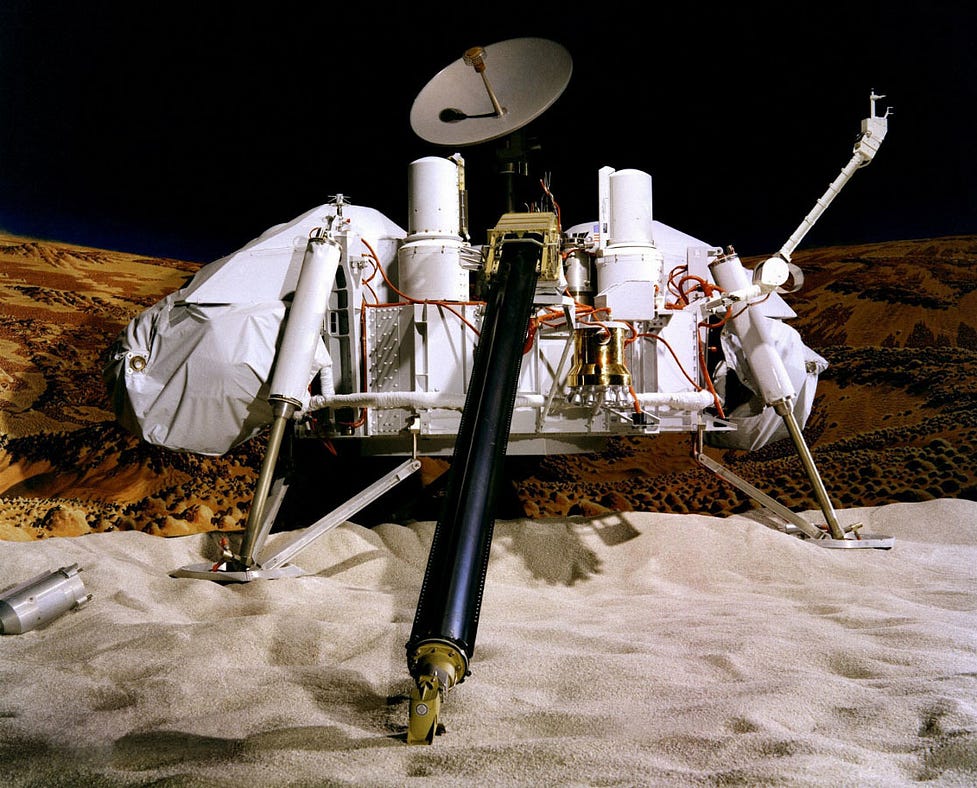It’s a curious story. A test sent to Mars during the 1976 Viking missions revealed positive signs of life. The test was duplicated on a different part of the Martian surface using several different strong controls. Having been carefully formulated by a group of scientists, the experiment itself was to reveal signs of microbial life on an extraterrestrial surface. No false positive nor false negative had ever occurred over the many thousands of instances the test had been run, and no scientist has been able to step forward since the Viking tests took place to provide conclusive evidence that would disprove their results. Yet it’s what happens next that is perhaps the most shocking part of the story.
Nothing. No follow up missions in the past 45 years bothered to repeat the experiment to provide more data. In fact, no experiments since Viking had bothered to even search for life on the Martian surface. It wasn’t until last year’s Perseverance mission that NASA once again sent specialized equipment to search for microbes on the Red Planet. So there it was: exciting results in the 70’s told us alien life exists and these remarkable results were pushed aside, never revisited, and — seemingly right after the missions — funding for the experiments ran out. Theories then surfaced trying to disprove the Viking results.

The test itself was called the Labeled Release (LR) experiment. It consisted of acquiring samples of Martian soil and then adding water and organic compounds to the samples. The compounds included nutrients like glycine, D-alanine, formate, and others, as well as radioactive carbon-14. If microorganisms were present in the soil then they would metabolize the nutrients and release the radioactive carbon out into the instrument’s chamber where it could then be detected. In a control version the sample was heated to high temperatures in order to kill the microorganisms. No radioactive gas would be detected in the sterilized samples.
The results showed exactly what the scientists needed for positive detection of life: radioactive carbon was detected in four samples but none was detected in duplicate samples heated for sterilization. Scientists even took the test one step further. The heat sample reached temperatures of 320° F (160° C) but if they could find a way to lower this temperature they would have better proof of Martian biology. This is because microbes evolving on the cold Martian surface would be more sensitive to heat. When the temperature was lowered to 122° F (50° C), the positive result was reduced, providing even more support that it had been a biological process. There were suggestions that chemicals could also produce this result, though which chemicals exactly remains unknown.
The LR experiment met all the requirements to confirm alien life. Yet very few people other than the experiment’s lead scientists saw it this way.


The problem is that other instruments and experiments on Viking didn’t support the theory of microbial presence. There were no signs of the organic compounds thought to be needed for life, prompting NASA to attribute the results to chemical — rather than biological — processes. Later on in 2007 the Phoenix mission would find perchlorates on Mars. The perchlorates would have made it difficult for the Viking instruments to detect organics in the sample, though at the same time the perchlorates themselves could also provide an abiotic explanation for the positive results.
Which, however, would be more difficult to believe: that there is no life on Mars? Or that there is? When you consider the fact that Mars and Earth have been exchanging material for billions of years it becomes difficult to believe that hardy terrestrial organisms have never contaminated the Martian surface, perhaps evolving over those billions of years into their own form of alien life. It seems too that every Mission to Mars reveals it to have been a beautiful and nurturing landscape in its earlier era. Complex organics, methane spikes, evidence of lakes and water erosion, and formations resembling stromatolite fossils have all been found by different missions.
To this day the lead scientists — Gil Levin and Patricia Ann Straat — maintain that the Viking missions did reveal life on Mars. Yet in the scientific community it remains a controversial topic. The experiment made a lot of assumptions, such as that the microbes would react to water or to the same nutrients as organisms here on Earth.

Both Levin and Straat proposed follow-up experiments that could help confirm the LR results. A new LR test could be sent to look for chiral metabolism. A chiral metabolism is a process that distinguishes between left and right-handed organic molecules, something that chemical reactions don’t ever do. This new kind of LR test has already been formulated and can be turned into an instrument for a future Martian rover. But NASA has opted to run their own tests instead. Core samples collected by Perseverance will return to Earth during later missions. NASA scientists believe that the instruments needed to prove the presence of life are too complex to be carried to another planet.
The LR experiments are not the only controversial findings of Martian life. Methane spikes and the meteorite ALH84001 are other debated instances. But it seems for now that we are left in a curious limbo of uncertainty. We eagerly await the samples from Perseverance, left both in a state of solitude and company. Strange to think that a few samples of dirt could change the way we view ourselves, and answer one of our most haunting questions.





























